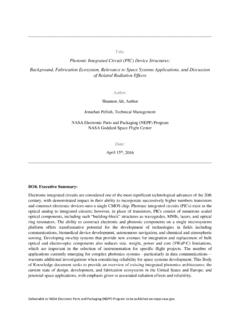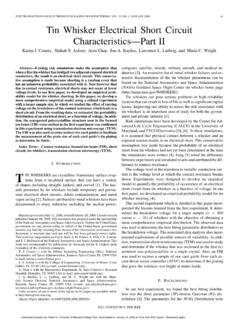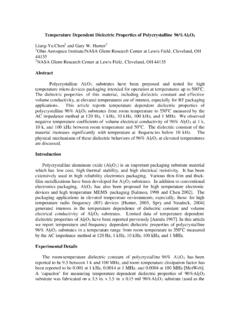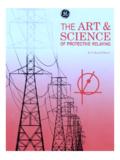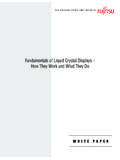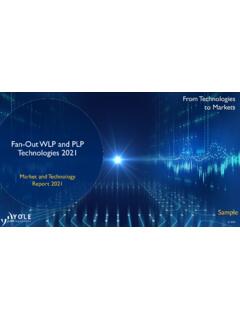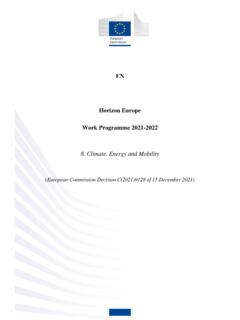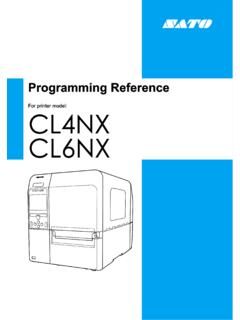Transcription of Radiation Effects on Electronics 101 - NASA
1 Radiation Effects on Electronics 101:Simple Concepts and New ChallengesKenneth A. NASA Electronic Parts and Packaging (NEPP) ProgramGroup Leader, Radiation Effects and Analysis Group (REAG), NASA/GSFCP roject Technologist, Living With a Star (LWS) Space Environment Testbeds (SET)2 NEPP Webex Presentation Radiation Effects 101 presented by Kenneth A. LaBel Apr 21,2004 Outline The Space Radiation Environment The Effects on Electronics The Environment in Action NASA Approaches to Commercial Electronics The Mission Mix Flight Projects Proactive Research Space Validations of Models and Test Protocols Final ThoughtsAtomic Interactions Direct IonizationInteraction with Nucleus Indirect Ionization Nucleus is Space Radiation EnvironmentSTARFISH detonation Nuclear attacks are not considered in this presentation4 NEPP Webex Presentation Radiation Effects 101 presented by Kenneth A.
2 LaBel Apr 21,2004 Space Environments and Related EffectsPlasmaChargingImpactsDragSurfaceE rosionUltraviolet & X-rayNeutralgas particlesParticleradiationMicro-meteoroi ds & orbital debrisIonizing &Non-IonizingDose Degradation of micro - Electronics Degradation of optical components Degradation of solar cellsSingleEventEffects Data corruption Noise on Images System shutdowns Circuit damage Degradation of thermal, electrical, optical properties Degradation of structural integrity Biasing of instrument readings Pulsing Power drains Physical damage Torques Orbital decay Structural damage DecompressionSpace Radiation Effectsafter Barth5 NEPP Webex Presentation Radiation Effects 101 presented by Kenneth A. LaBel Apr 21,2004 Space Radiation EnvironmentTrapped ParticlesProtons, Electrons, Heavy IonsafterNikkei Science, Japan, by K.
3 EndoGalactic Cosmic Rays (GCRs)Solar Protons&Heavier IonsDeep-space missions may also see: neutrons from backgroundor radioisotope thermal generators (RTGs) or other nuclear sourceAtmosphere and terrestrial may see GCR and secondaries6 NEPP Webex Presentation Radiation Effects 101 presented by Kenneth A. LaBel Apr 21,2004 Sunspot Cycle:An Indicator of the Solar CycleLength Varies from 9 -13 Years7 Years Solar Maximum, 4 Years Solar Minimum19471997 Years050150200250100300 Sunspot NumbersCycle 18 Cycle 22 Cycle 21 Cycle 20 Cycle 19after Lund Observatory7 NEPP Webex Presentation Radiation Effects 101 presented by Kenneth A. LaBel Apr 21,2004 Solar Particle EventsHolloman AFB/SOON Cyclical (Solar Max, Solar Min) 11-year AVERAGE (9 to 13) Solar Max is more active time period Two types of events Gradual (Coronal Mass Ejections CMEs) Proton rich Impulsive (Solar Flares) Heavy ion rich Abundances Dependent on Radial Distance from Sun Particles are Partially Ionized Greater Ability to Penetrate Magnetosphere than GCRs8 NEPP Webex Presentation Radiation Effects 101 presented by Kenneth A.
4 LaBel Apr 21,2004 Solar Proton Event -October 198910-410-310-210-110010110210310410515 1617181920212223242526272829303112345678 9101112131415-2000200 OctoberNovemberCounts/cm2/s/ster/MeVnTPr oton Fluxes -99% Worst Case EventGOES Space Environment Monitor9 NEPP Webex Presentation Radiation Effects 101 presented by Kenneth A. LaBel Apr 21,2004 Free-Space Particles: Galactic Cosmic Rays (GCRs) or Heavy Ions Definition A GCR ion is a charged particle (H, He, Fe, etc) Typically found in free space (galactic cosmic rays or GCRs) Energies range from MeV to GeVs for particles of concern for SEE Origin is unknown Important attribute for impact on Electronics is how much energy is deposited by this particle as it passes through a semiconductor material.
5 This is known as Linear Energy Transfer or LET (dE/dX).CREME 96, Solar Minimum, 100 mils ( mm) Al10-110010110210-810-710-610-510-410-31 0-210-1100101102103104 GEOGTOMEOEOSLEOZ = 2 -92 LETF luence(#/cm2/day)LET (MeV-cm2/mg)Commercial Technology SensitivityTime10 NEPP Webex Presentation Radiation Effects 101 presented by Kenneth A. LaBel Apr 21,2004 Trapped Particles in the Earth s Magnetic Field: Proton & Electron Intensities123456789101234L-ShellAP-8 ModelAE-8 ModelEp> 10 MeVEe> 1 MeV#/cm2/sec#/cm2/secA dip in the earth s dipole moment causes an asymmetry in the picture above:The South Atlantic Anomaly (SAA)11 NEPP Webex Presentation Radiation Effects 101 presented by Kenneth A. LaBel Apr 21,2004 SAA and Trapped Protons: Effects of the Asymmetry in the Proton Belts on SRAM Upset Rate at Varying Altitudes on CRUX/APEX-180-150-120-90-60-300306090120 150180 Longitude-90-75-60-45-30-150153045607590 LatitudeHitachi 1M:Altitude:1250km - to to to to to to to to to 1M:Altitude:650km - to to to to to to to to to 1M:Altitude:1750km - to to to to to to to to to 1M:Altitude:2450km - to to to to to to to to to Webex Presentation Radiation Effects 101 presented by Kenneth A.
6 LaBel Apr 21,2004 Solar Cycle Effects :Modulator and Source Solar Maximum Trapped Proton Levels Lower, Electrons Higher GCR Levels Lower Neutron Levels in the Atmosphere Are Lower Solar Events More Frequent & Greater Intensity Magnetic Storms More Frequent --> Can Increase Particle Levels in Belts Solar Minimum Trapped Protons Higher, Electrons Lower GCR Levels Higher Neutron Levels in the Atmosphere Are HigherLight bulb shaped CMEcourtesy of SOHO/LASCO C3 Instrument Solar Events Are RareThe EffectsDNA double helixPre and Post IrradiationBiological Effects are a key concernfor lunar and Mars missions14 NEPP Webex Presentation Radiation Effects 101 presented by Kenneth A. LaBel Apr 21,2004 Radiation Effects and Spacecraft Critical areas for design in the natural space Radiation environment Long-term Effects Total ionizing dose (TID) Displacement damage Transient or single particle Effects (Single event Effects or SEE) Soft or hard errors Mission requirements and philosophies vary to ensure mission performance What works for a shuttle mission may not apply to a deep-space missionAn Active Pixel Sensor (APS) imagerunder irradiation with heavy ions at TexasA&M University Cyclotron15 NEPP Webex Presentation Radiation Effects 101 presented by Kenneth A.
7 LaBel Apr 21,2004 Total Ionizing Dose (TID) Cumulative long term ionizingdamage due to protons & electrons Effects Threshold Shifts Leakage Current Timing Changes Functional Failures Unit of interest is krads(material) Can partiallymitigate with shielding Low energy protons ElectronsErase Voltage vs. Total Dose for 128-Mb Samsung Flash Memory024681012140246810 Total Dose [krad(Si)]Voltage During Erase FunctionFailed to erase16 NEPP Webex Presentation Radiation Effects 101 presented by Kenneth A. LaBel Apr 21,2004 Displacement Damage (DD) Cumulative long term non-ionizingdamage due to protons, electrons, and neutrons Effects Production of defects which results in device degradation May be similar to TID Effects Optocouplers, solar cells,CCDs, linear bipolar devices Unit of interest is particle fluence for each energy mapped to test energy Non-ionizing energy loss (NIEL) is one means of discussing Shielding has some effect -depends on location of device Reduce significant electron and some proton damageNot particularly applicable to CMOS microelectronics17 NEPP Webex Presentation Radiation Effects 101 presented by Kenneth A.
8 LaBel Apr 21,2004 Single Event Effects (SEEs) An SEE is caused by a single charged particleas it passes through a semiconductor material Heavy ions Direct ionization Protons for sensitive devices Nuclear reactions for standard devices Effects on Electronics If the LET of the particle (or reaction) is greater than the amount of energy or critical chargerequired, an effect may be seen Soft errors such as upsets (SEUs) or transients (SETs), or Hard (destructive) errors such aslatchup(SEL), burnout (SEB), or gate rupture (SEGR) Severity of effect is dependent on type of effect system criticalityDestructive event in a COTS 120V DC-DC Converter18 NEPP Webex Presentation Radiation Effects 101 presented by Kenneth A. LaBel Apr 21,2004 Radiation Effects on Electronics and the Space Environment Three portions of the natural space environment contribute to the Radiation hazard Solar particles Protons and heavier ions SEE, TID, DD Free-space particles GCR For earth-orbiting craft, the earth s magnetic field provides some protection for GCR SEE Trapped particles(in the belts) Protons and electrons including the South Atlantic Anomaly (SAA) SEE (Protons) DD, TID (Protons, Electrons)The sun acts as a modulator andsource in the space environmentThe Environment in Action There s a little black spot on the sun today 20 NEPP Webex Presentation Radiation Effects 101 presented by Kenneth A.
9 LaBel Apr 21,2004 Recent Solar Events A Few Notes and Implications In Oct-Nov of this year, a series of X-class (X-45!) solar events took place High particle fluxes were noted Many spacecraft performed safing maneuvers Many systems experienced higher than normal (but correctable) data error rates Several spacecraft had anomalies causing spacecraft safing Increased noise seen in many instruments Drag and heating issues noted Instrument FAILURES occurred Two known spacecraft FAILURES occurred Power grid systems affected, communication systems Webex Presentation Radiation Effects 101 presented by Kenneth A. LaBel Apr 21,2004 SOHO LASCO C2 of the Solar Event22 NEPP Webex Presentation Radiation Effects 101 presented by Kenneth A.
10 LaBel Apr 21,2004 Solar Event Effect -Solar Array Degradation on CLUSTER SpacecraftMany other spacecraft tonoted degradation as Webex Presentation Radiation Effects 101 presented by Kenneth A. LaBel Apr 21,2004 Science Spacecraft Anomalies During Recent Solar EventsType of EventSpacecraft/InstrumentNotesSpontaneo us Processor ResetsRHESSI3 events; all recoverableCLUSTERSeen on some of 4 spacecraft; recoverableChipSATS/C tumbled and required ground command to correctHigh Bit Error RatesGOES 9,10 Magnetic Torquers DisabledGOES 9, 10, 12 Star Tracker ErrorsMERE xcessive event countsMAPStar Tracker Reset occurredRead ErrorsStardustEntered safe mode; recoveredFailure?Midori-2 Memory ErrorsGENESIS19 errors on 10/29 ManyIncrease in correctable error rates on solid-state recorders noted in many spacecraft24 NEPP Webex Presentation Radiation Effects 101 presented by Kenneth A.

